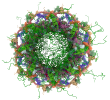Ensemble information?
This entry consists of 0 distinct ensemble.
Representation ?
This entry has 1 representation(s).
| ID | Model(s) | Entity ID | Molecule name | Chain(s) [auth] | Total residues | Rigid segments | Flexible segments | Model coverage/ Starting model coverage (%) |
Scale |
|---|---|---|---|---|---|---|---|---|---|
| 1 | 1 | 1 | XcpG | A | 134 | 1-24, 25-134 | - |
100.00
/ 82.09 |
Atomic |
| B | |||||||||
| C | |||||||||
| D | |||||||||
| E | |||||||||
| F | |||||||||
| G | |||||||||
| H | |||||||||
| I | |||||||||
| J | |||||||||
| K | |||||||||
| L | |||||||||
| M | |||||||||
| N | |||||||||
| O | |||||||||
| P | |||||||||
| 2 | XcpH | Q | 161 | 1-30, 31-161 | - |
100.00
/ 81.37 |
Atomic | ||
| 3 | XcpI | R | 120 | 1-31, 32-120 | - |
100.00
/ 74.17 |
Atomic | ||
| 4 | XcpJ | S | 199 | 1-37, 38-199 | - |
100.00
/ 81.41 |
Atomic | ||
| 5 | XcpK | T | 309 | 1-36, 37-309 | - |
100.00
/ 88.35 |
Atomic |
Datasets used for modeling ?
There are 7 unique datasets used to build the models in this entry.Methodology and software?
This entry is a result of 1 distinct protocol.| Step number | Protocol ID | Method name | Method type | Method description | Number of computed models | Multi state modeling | Multi scale modeling |
|---|---|---|---|---|---|---|---|
|
1
|
1
|
Docking
|
HADDOCK
|
None
|
1000
|
False
|
False
|
|
2
|
1
|
Helix models
|
Homology modeling
|
None
|
None
|
False
|
False
|
|
3
|
1
|
Add helices
|
Manual modeling
|
None
|
None
|
False
|
False
|
|
4
|
1
|
Modeling Helices
|
Semi-Manual modeling
|
None
|
300
|
False
|
False
|
|
5
|
1
|
Create XcpG filament
|
Manual modeling
|
None
|
None
|
False
|
False
|
|
6
|
1
|
Minimize filament
|
Minimization
|
None
|
10
|
False
|
False
|
| ID | Software name | Software version | Software classification | Software location |
|---|---|---|---|---|
|
1
|
Not available
|
Visualization-modeling
|
||
|
2
|
Not available
|
Docking
|
||
|
3
|
Not available
|
Programing language
|
||
|
4
|
Not available
|
Modeling
|
||
|
5
|
Not available
|
Homology modeling
|
